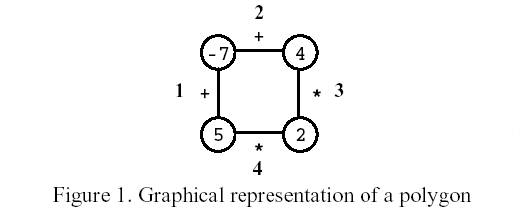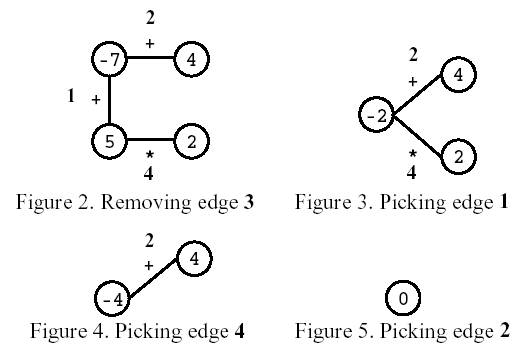poj1179 區間dp(記憶化搜索寫法)有巨坑!
http://poj.org/problem?id=1179
Description
Polygon is a game for one player that starts on a polygon with N vertices, like the one in Figure 1, where N=4. Each vertex is labelled with an integer and each edge is labelled with either the symbol + (addition) or the symbol * (product). The edges are numbered from 1 to N.
On the first move, one of the edges is removed. Subsequent moves involve the following steps:
?pick an edge E and the two vertices V1 and V2 that are linked by E; and
?replace them by a new vertex, labelled with the result of performing the operation indicated in E on the labels of V1 and V2.
The game ends when there are no more edges, and its score is the label of the single vertex remaining.
Consider the polygon of Figure 1. The player started by removing edge 3. After that, the player picked edge 1, then edge 4, and, finally, edge 2. The score is 0.

Write a program that, given a polygon, computes the highest possible score and lists all the edges that, if removed on the first move, can lead to a game with that score.
Input
Your program is to read from standard input. The input describes a polygon with N vertices. It contains two lines. On the first line is the number N. The second line contains the labels of edges 1, ..., N, interleaved with the vertices‘ labels (first that of the vertex between edges 1 and 2, then that of the vertex between edges 2 and 3, and so on, until that of the vertex between edges N and 1), all separated by one space. An edge label is either the letter t (representing +) or the letter x (representing *).3 <= N <= 50
For any sequence of moves, vertex labels are in the range [-32768,32767].
Output
Sample Input
4 t -7 t 4 x 2 x 5
Sample Output
33 1 2
/**
hdu 1179 區間dp(記憶化搜索寫法)
題目大意:給定一個n個節點的環,環的每條邊代表+或者*。問最開始把哪條邊去掉。剩下的做運算能夠得到最大的表達式的值
解題思路:枚舉去掉n條邊的隨意一條,然後區間dp來寫。值得一提的是兩個最小的負數相乘就會是最大的值,所以我們不能僅僅維護最大值
同一時候也須要維護最小值。坑啊,這個陷阱太厲害了
*/
#include <stdio.h>
#include <string.h>
#include <iostream>
#include <algorithm>
using namespace std;
int num[105],sym[105],n;
int dpmin[155][155],dpmax[155][155];
int vismin[155][155],vismax[155][155];
int MAX(int i,int j);
int MIN(int i,int j);
int MAX(int x,int y)
{
if(vismax[x][y])return dpmax[x][y];
vismax[x][y]=1;
if(y==x)
{
dpmax[x][y]=num[x];
return dpmax[x][y];
}
dpmax[x][y]=-1000000007;
for(int i=x;i<y;i++)
{
int l=MAX(x,i);
int ll=MIN(x,i);
int r=MAX(i+1,y);
int rr=MIN(i+1,y);
if(sym[i+1])
{
dpmax[x][y]=max(dpmax[x][y],l+r);
}
else
{
int ans=l*r;
ans=max(ans,l*rr);
ans=max(ans,ll*r);
ans=max(ans,ll*rr);
dpmax[x][y]=max(dpmax[x][y],ans);
}
}
return dpmax[x][y];
}
int MIN(int x,int y)
{
if(vismin[x][y])return dpmin[x][y];
vismin[x][y]=1;
if(y==x)
{
dpmin[x][y]=num[x];
return dpmin[x][y];
}
dpmin[x][y]=1000000007;
for(int i=x;i<y;i++)
{
int l=MAX(x,i);
int ll=MIN(x,i);
int r=MAX(i+1,y);
int rr=MIN(i+1,y);
if(sym[i+1])
{
dpmin[x][y]=min(dpmin[x][y],ll+rr);
}
else
{
int ans=l*r;
ans=min(ans,l*rr);
ans=min(ans,ll*r);
ans=min(ans,ll*rr);
dpmin[x][y]=min(dpmin[x][y],ans);
}
}
return dpmin[x][y];
}
int main()
{
while(~scanf("%d%*c",&n))
{
for(int i=0;i<n;i++)
{
char ch;
scanf("%c %d%*c",&ch,&num[i]);
num[i+n]=num[i];
sym[i+n]=sym[i]=(ch=='t');
}
memset(dpmin,0,sizeof(dpmin));
memset(dpmax,0,sizeof(dpmax));
memset(vismin,0,sizeof(vismin));
memset(vismax,0,sizeof(vismax));
int maxx=-1000000007;
int sum[55],id;
for(int i=0;i<n;i++)
{
int ans=MAX(i,i+n-1);
/** for(int j=i;j<=i+n-1;j++)
{
printf("%d %c ",num[j],sym[j+1]==0?'*':'+');
}
printf("\n%d\n",ans);*/
if(ans>maxx)
{
maxx=ans;
id=0;
sum[id++]=i+1;
}
else if(ans==maxx)
{
sum[id++]=i+1;
}
}
printf("%d\n",maxx);
for(int i=0;i<id;i++)
{
printf(i==id-1?"%d\n":"%d ",sum[i]);
}
}
return 0;
}
poj1179 區間dp(記憶化搜索寫法)有巨坑!
